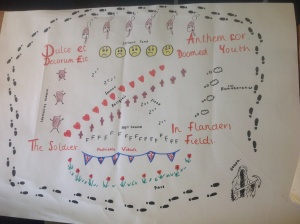Sociograms – making links
Sociograms are a great way to encourage students to make links. I use them for getting students to make links between poems, but have also used them as a strategy for getting students to make links between characters in a play or novel, or as a basis for student presentations.
In a nutshell, a sociogram is a fun, visual way to explore ideas. It involves little input from the teacher, enabling you to circulate, encourage, intervene or guide according to student need. One of the pleasures of setting them as a learning activity is that students always surprise me with new links and interpretations.
The image below shows some students making links between poems. To set it up, the titles of the poems are spread around a big piece of sugar paper – the bigger the better. Coloured pens or markers are always popular and can be used to separate out ideas so they can be picked out easily.
The students here made connections by drawing images which connected with the link. So, poems that featured the theme of death had the footsteps of a grim reaper connecting them (you can make him out in the right hand corner). Poems with a patriotic tone feature a ‘flags’ link, and so on.
Apart from a useful strategy for linking poems, I’ve used them for learning about the relationships between characters in Shakespeare plays in KS3. Like the poems, the characters’ names are spread out around the sugar paper, and what links them is used as an image to connect them. For example, characters who are in love might be connected by hearts; warring characters can be connected by an image which reflects the nature of their conflict – swords, guns, megaphones – whatever is appropriate.
Sociograms can be differentiated in a number of ways. You can leave students to choose their own connections or provide symbols for them to use as an extra scaffold. Colour coding can be used for different assessment objectives such as themes/ideas, language, structure, form or context, enabling students to work on different aspects of a topic on the same sociograms.
An additional use for them is that they make a great basis for student presentations. The magic of them is that there are few, if any, words, but provoke some analytical thinking. Students who use their sociograms as a basis for presentation cannot simply read what they have prepared, but use the symbols as prompts. This works most successfully when they have a little preparation time to organise a structure before talking to the class.
Finally, students enjoy them and encourage independence in terms of task and thinking.
